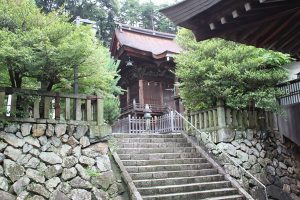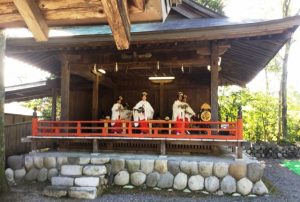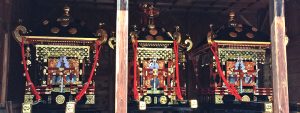The Main Shrine

- The oldest known main shrine building was completed on March 17, 1315 on a higher ground at about 50 meters in the back of the current one.
The style of the former building is unknown. - In November 1577, Horiike Chiyojumaru relocated the main building to the present position.
- In April 1602, Nishio Bungonokami Mitsunori renovated the building, and another renovation was done by Mr. Okada in April 1672.
- On September 26, 1959, the Ise Bay Typhoon uprooted a large Ichii-gashi (Quercus gilva Blume), which fell onto the main shrine building to smash it completely.
The current main cuilding was rebuilt 5 meters north of the collapsed one from Edo period, to face the hall of worship.
In September 1961, the main building was reconstructed with as many original members as possible under the guidance of Mr Kitamura Genbee, a technical official of the then Ministry of Education, to resume the original design from 1315. At the same time, the members that represented the Edo period-style architecture were used to build the Stage.
Construction of the Stage

The stage was built to conserve the remaining members of the collapsed main building due to the Ise Bay Typhoon in 1959.
Its pillars are the frontal pillars from the former main shrine, and so are the red balustrade and the four baluster finials.
The baluster finials are painstakingly carved out of single block of wood.
Some other reused members from the former main shrine show characteristics of periods other than early Edo period.
History of the Portable Shrines
The Three Portable Shrines
Three portable shrines belong to Miwa Shrine. They consist of the main portable shrine in hexagonal shape and two are in square shape. When they go on the parade, one of the square shape shrine takes the head of the parade, the main shrine comes next, and the other square shrine follows them.
At the bottom of the main portable shrine is a handwritten information of its manufacture in 1714 and the name of the craftsman in Kyoto.
The mirrors of the two other portable shrines are inscribed with the date of manufacture (April 7, 1717) and the manufacturer’s name.
It was around 300 years ago that we started to use these portable shrines built in Kyoto.
These three portable shrines are depicted together with the early floats in a picture scroll of Festival from 1727 that the shrine owns.
It is believed to have been the time, when the three portable shrines joined the shrine and the procession of Ibi Festival took the current form.
These three portable shrines are designated important tangible folkloric properties of Ibigawa-cho.


Maha-prajnaparamita sutra held in the azekura (storage)
Maha-prajnaparamita sutra (important cultural property of Ibigawa-cho), one of the shrine treasures Maha-prajnaparamita sutra had been read in front of the gods until the first year of Meiji (1868), when it was abolished as Shitoism was separated from Buddhism by the government edict.
There are 500 scrolls to the sutra, which are held in two boxes, each containing 250 scrolls.
On 131st volume, there is mentioning of ‘Ishiyama Temple in Nishi-kasugai-gun, Owari Province, October 26, 1378, thus the set of scrolls is considered to have dated backaround that time. The note of authentication on the box refers to the date, September 16, 1524.
They are designated cultural properties of Ibigawa-cho.

